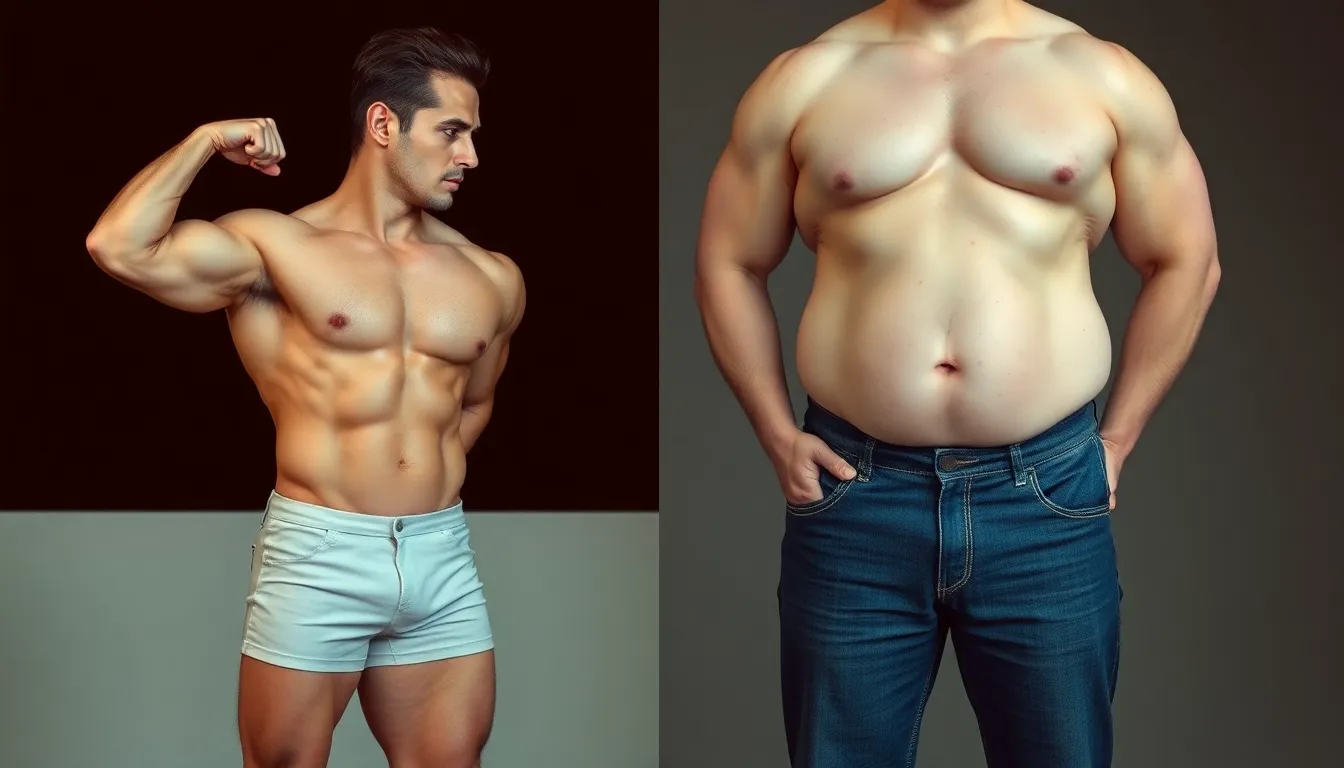Table of Contents
ToggleWhen it comes to the age-old debate of muscle versus fat, pictures tell a story that numbers just can’t capture. Ever seen a side-by-side comparison of the two? It’s like comparing a sleek sports car to a cozy couch—both have their charm, but one sure looks a lot better in a tight pair of jeans.
Understanding Muscle and Fat Composition
Muscle and fat differ significantly in composition, density, and appearance. Muscle tissue is denser than fat, which means it takes up less space in the body. For instance, a pound of muscle occupies approximately 18% less volume than a pound of fat. This density difference contributes to the distinct visuals noted in before-and-after pictures.
Fat appears softer and bulkier compared to the defined, firm look of muscle. When comparing images of individuals with the same body weight, one might see a toned physique versus a softer silhouette. This visual contrast highlights how muscle contributes to a more athletic shape and better-defined body proportions.
Health markers change with muscle and fat distribution. Increased muscle mass correlates with higher metabolism, promoting better calorie burning even at rest. Fat, specifically visceral fat, poses health risks, including cardiovascular diseases and diabetes. Elevated muscle levels support overall fitness and functional ability.
Visual comparisons allow for immediate understanding of body composition. It’s critical to recognize that two people weighing the same might differ vastly in muscle and fat ratios. Evaluating images reveals significant differences in how the human body presents itself, emphasizing the importance of not focusing solely on weight.
Ultimately, the conversation about muscle versus fat extends beyond aesthetics. Measuring body composition using tools like DEXA scans or bioelectrical impedance analysis reveals more accurate insights into health and fitness levels. Observing images of muscle and fat reinforces key concepts in health, wellness, and fitness.
Visual Differences in Muscle vs Fat

Visual comparisons between muscle and fat reveal striking differences in appearance and shape. Understanding these characteristics helps illustrate the distinct roles each component plays in body composition.
Characteristics of Muscle Tissue
Muscle tissue is dense and compact, leading to a firmer appearance. Defined contours often accompany muscle, enhancing athletic aesthetics. Muscle weighs more than fat but occupies less space, contributing to a lean silhouette. Individuals with higher muscle mass typically showcase better-defined body proportions. This density results in an overall tighter look, even if body weight remains unchanged. Enhanced metabolic activity accompanies increased muscle, aiding in effective calorie burning.
Characteristics of Fat Tissue
Fat tissue appears softer and is less dense than muscle, giving it a bulkier feel. Fat tends to accumulate in specific areas, such as the abdomen and thighs, affecting body shape. This accumulation can create a rounder appearance, unlike the defined look associated with muscle. Additionally, fat is more likely to shift and jiggle, lacking the firmness of muscle. Health-wise, high levels of fat, particularly visceral fat, pose risks, including cardiovascular issues. Individuals with more fat may experience altered body proportions that differ significantly from their muscle-dominant counterparts.
The Impact of Same Weight Muscle vs Fat Pictures
Visual representations of muscle and fat help clarify their impact on body composition. People often understand differences better through images instead of numbers.
Perception vs Reality
Perceptions of body weight vary widely, especially when comparing muscle and fat. An individual weighing 150 pounds who has a high muscle mass may look significantly leaner than someone with the same weight composed mainly of fat. Heightened visibility of muscle definition contributes to a more athletic appearance. Clothing fit also differs, as muscle allows for a more tailored look, while fat can create a bulkier silhouette. Images emphasizing these differences reinforce the belief that two people of the same weight can portray vastly different images.
Psychological Effects of Weight Perception
Weight perception significantly influences body image and self-esteem. Individuals may struggle with their self-image based on misconceptions about muscle versus fat. Social media frequently perpetuates unrealistic standards, showcasing toned bodies while neglecting the diversity of body compositions. This discrepancy can lead to feelings of inadequacy, especially if someone feels they don’t fit the ideal portrayed online. The psychological impact of seeing muscle-heavy images contrasts starkly with those emphasizing fat, often leading to unhealthy comparisons. Recognizing the nuanced differences between these compositions aids in fostering a healthier mindset toward self-image and body acceptance.
Importance of Body Composition
Understanding body composition remains crucial for evaluating health and fitness. It’s essential to recognize how muscle and fat differ, particularly regarding physical appearance and health implications. Muscle is denser than fat, occupying about 18% less volume per pound. This density creates a firmer, more defined look, enhancing shape and aesthetics in individuals with higher muscle mass.
Typically, muscle contributes to a lean silhouette and showcases better-defined body proportions. Even if weight remains the same, the visual difference can be significant. Individuals with greater muscle mass often exude an athletic appearance and improved self-confidence.
Fat, in contrast, appears softer and tends to accumulate in specific areas, leading to different body shapes. While a person with more fat may weigh the same as someone with more muscle, their overall appearance can vary dramatically. The rounder contours associated with fat can influence how clothes fit, affecting individual self-perception and self-esteem.
Body composition measurements, like DEXA scans or bioelectrical impedance analysis, offer deeper insights into an individual’s health. These tools provide valuable data beyond simple weight metrics, illustrating the importance of seeing the actual muscle-to-fat ratios. Images depicting muscle and fat can help reinforce these concepts, promoting a better understanding of health and wellness. Misconceptions about weight and composition can negatively impact self-image, especially in a social media culture that often presents unrealistic body standards. Fostering a healthier mindset towards body acceptance relies on education and accurate representations of body composition.
Understanding the differences between muscle and fat is essential for anyone looking to improve their health and fitness. Visual comparisons reveal that individuals with higher muscle mass often enjoy a more defined and appealing physique. This not only enhances their appearance but also boosts self-confidence.
Recognizing that two people can weigh the same yet look entirely different underscores the importance of body composition. By focusing on muscle development rather than solely on weight, individuals can achieve a healthier and more satisfying body image. Embracing this knowledge fosters a positive mindset toward self-acceptance and encourages healthier lifestyle choices.





